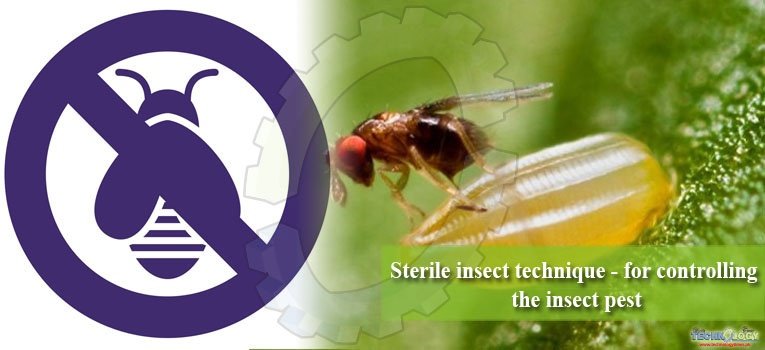Increased resistance in pests and increase in dangerous environmental pollution are one of the major issues. Sterile insect technique (SIT) is a useful and environmentally friendly technique.

In this technique the sterile insects are released in the wild population to eliminate their specie in that area. In detail, the SIT is a biological control technique in which the living sterile insects are reared, sterilized using radiations and then released in the area where they mate with females and thus result in no offspring.
Thus the sterilize insects are used against their own specie to control the insects population. For this purpose the rays such as gamma rays and X-rays are used to sterile the male. Firstly insecticide is sprayed to bring down the pest population below the economic threshold level which later is controlled by the release off sterile insects to completely eradicate the pest population from that area.
SIT technique differ from the classical biological technique:
- As the sterile insects cannot self-replicate so they cannot establish in environment
- Species-specific
- No danger of induction of non-native specie
Benefits of SIT technique:
Integrated with different management techniques the SIT has been successful in managing dangerous pest population that include screwworm, oriental fruit flies, melon fruit flies, moths and mosquitoes.
Other benefits include,
- A big reduction in the losses of crops and livestock production
- No quarantine restrictions issues and thus controlling the pest population very suitably
- Reduction in human health due to successful controlling of mosquitoes and other dangerous pest through this environmentally safe technique
- Creating jobs
- Reduction in insecticides use
- Create opportunities for deserving students to earn research fellowships
- Protect the food supply and promote sustainable resource use through environmentally safe pest control and increased fruit production
- Build coalitions, both domestic and international: government, industry, commercial and resource-limited farmers, academia, and international organisations.
Current targets:
- Aedes mosquitoes vector for dengue and yellow fever
- Tsetse fly vector of the sleeping sickness.
- Anopheles mosquito vector of the Malaria, example Anopheles arabiensis
- Painted apple moth in British Columbia, Canada.
Application to various insect pests:
|
Insect |
Previous sites |
Current sites |
|
Screwworm |
Curaçao, USA, Mexico, Puerto Rico, US Virgin Islands |
Guatemala, Belize, Libya |
|
Mediterranean fruit fly |
Italy*, Peru*, Mexico, USA (California), Israel* |
Guatemala, USA (Hawaii) |
|
Caribbean fruit fly |
USA (Florida)* |
USA (Florida) fly-free zone |
|
Melon fly |
Japan* |
Japan, Brazil |
|
Oriental fruit fly |
Rota, Hawaii* |
|
|
Onion fly |
Netherlands* |
Netherlands (control) |
|
Mexican fruit fly |
USA/Mexico* |
USA/Mexico (quarantine + fly-free zone) |
|
Cherry fruit fly |
Switzerland* |
|
|
Pink bollworm |
USA* |
USA (quarantine) |
|
Codling moth |
Canada*, USA* |
Canada (control) |
|
Gypsy moth |
USA* |
USA (quarantine) |
|
Tsetse flies |
United Republic of Tanzania*, Nigeria*, Nigeria, Zanzibar |
|
|
(Four species) |
Burkina Faso* |
|
|
Tobacco budworm |
USA* |
|
|
Boll weevil |
USA* |
|
|
Sheep blowfly |
Australia* |
|
|
Mosquitoes |
El Salvador* |
|
|
Stable fly |
St Croix, USA* |
|
|
Tobacco hornworm |
St Croix, USA* |
|
|
Cattle fevertick |
St Croix, USA* |
St Croix. USA |
Note: The table indicates the insect pests for which SIT or a related genetic control method is being used, has been used, or is being developed. The only objective is eradication unless stated.
Drawbacks:
- Sometimes it becomes necessary to spray again to suppress the pest population thus repeated spraying may be a drawback.
- Difficult to separate individuals on the sex bases before the application of radioactive rays.
- Radiations also affects the health of the male thus the male when released in the field may not work effectively.
- One of a major drawback is that this technique should be applied to a large area otherwise the wild population may migrate.
- Another major drawback is the cost of this technique.
Genetic modification:
The RIDL technique (Release of insects carrying a dominant lethal ) is useful technique in which a repressible dominant lethal gene is introduced in the insect genomic. This can be repressed by tetracycline which is a additive and is provided in the laboratory reared insects.
So they can survive due to the introduction of lethal gene but when these insects are released in the environment the offspring did not have this additive in their food and thus they died due to the effect of the lethal gene. These insects are also released with genetic markers to later identify.
Conclusion and perspectives:
Biotechnological techniques which based on the genetically modified organisms are still under development. The residues of the radiations may last for sometimes in the environment so these techniques may have a drawback. But as these are highly species specific thus it did not have any harmful effect if another specie eat that infected insect.
The RIDL is also species specific and thus are environmentally safe. Such techniques has been very suitable in controlling the pest population and very impressive successful examples are of the control of the screwworm and eradication of the tsetse fly in North and Central America livestock industry and in Mexico respectively. From successful examples it is clear that the SIT technique for suppression is cost competitive in addition to its environmental benefits.
